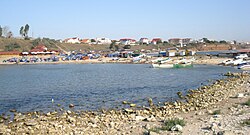
Northern Dobruja is the part of Dobruja within the borders of Romania. It lies between the lower Danube River and the Black Sea, bordered in the south by Southern Dobruja, which is a part of Bulgaria.

Dobruja or Dobrudja is a geographical and historical region in Southeastern Europe that has been divided since the 19th century between the territories of Bulgaria and Romania. It is situated between the lower Danube River and the Black Sea, and includes the Danube Delta, the Romanian coast, and the northernmost part of the Bulgarian coast. The territory of Dobruja is made up of Northern Dobruja, which is a part of Romania, and Southern Dobruja, which is a part of Bulgaria.

Constanța, historically known as Tomis or Tomi, is a port city in the Dobruja historical region of Romania. As the country's fourth largest city and principal port on the Black Sea coast, Constanța is the capital of Constanța County. It is also the oldest continuously inhabited city in the region, founded around 600 BC, and among the oldest in Europe.
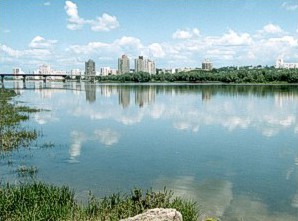
The Dniester is a transboundary river in Eastern Europe. It runs first through Ukraine and then through Moldova, finally discharging into the Black Sea on Ukrainian territory again.

The Danube–Black Sea Canal is a navigable canal in Romania, which runs from Cernavodă on the Danube river, via two branches, to Constanța and Năvodari on the Black Sea. Administered from Agigea, it is an important part of the waterway link between the North Sea and the Black Sea via the Rhine–Main–Danube Canal. The main branch of the canal, with a length of 64.4 km (40.0 mi), which connects the Port of Cernavodă with the Port of Constanța, was built in 1976–1984, while the northern branch, known as the Poarta Albă–Midia Năvodari Canal, with a length of 31.2 km (19.4 mi), connecting Poarta Albă and the Port of Midia, was built between 1983 and 1987.
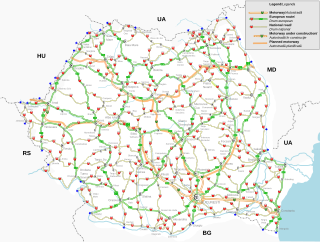
Public roads in Romania are ranked according to importance and traffic as follows:

Sebeș is a city in Alba County, central Romania, southwestern Transylvania.
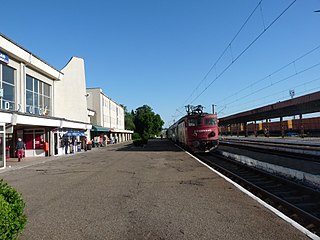
Adjud is a city in Vrancea County, Western Moldavia, Romania. It has a population of 15,178 inhabitants. It lies at a railway junction which has a classification yard and a passenger station. Adjud, situated north of the point where the river Trotuș enters the Siret, used to be a marketplace.

Adamclisi is a commune in Constanța County, in the Dobrogea region of Romania.
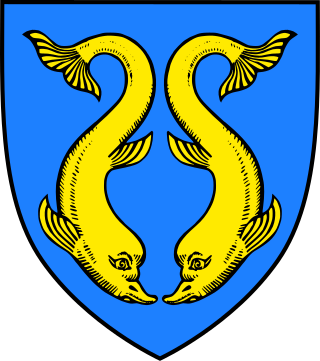
The Dobrujan Germans were an ethnic German group, within the larger category of Black Sea Germans, for over one hundred years. German-speaking colonists entered the approximately 23,000 km2 area of Dobruja around 1840 and mostly left during the relocation of 1940. Dobruja is a historical region on the west coast of the Black Sea. They are part of the Romanian Germans.

Trajan's Wall is the name used for several linear earthen fortifications (valla) found across Eastern Europe, Moldova, Romania, and Ukraine. Contrary to the name and popular belief, the ramparts were not built by Romans during Trajan's reign, but during other imperial periods. Furthermore, the association with the Roman Emperor may be a recent scholarly invention, only entering the imagination of the locals with the national awakening of the 19th century. Medieval Moldavian documents referred to the earthworks as Troian, likely in reference to a mythological hero in the Romanian and Slavic folklore. The other major earthen fortification in Romania, Brazda lui Novac, is also named after a mythological hero.
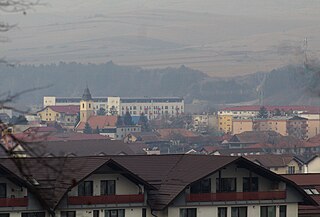
Florești is a commune in Cluj County, Transylvania, Romania. It is composed of three villages: Florești, Luna de Sus (Magyarlóna) and Tăuți (Kolozstótfalu) and is part of the Cluj-Napoca metropolitan area, being located less than 8 km west of Cluj-Napoca on DN1.

Limanu is a commune in Constanța County, Northern Dobruja, Romania.

Kranevo is a coastal village on the northern Bulgarian Black Sea Coast, part of Balchik Municipality, Dobrich Province. It is located in the historical region of Southern Dobruja. Between 1913 and 1940 it was part of Romania, being its southernmost settlement. An important lighthouse is installed on Cape Ekrene, 3 km south of the village. Kranevo enjoys high tourist population during summers and two of the reasons are its proximity to Albena and its clearly lower prices.
Bașcalia is a village in Basarabeasca District, Moldova.
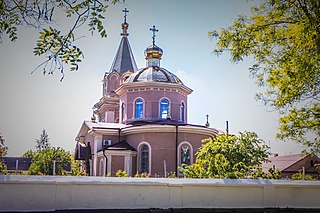
Shevchenkove is a village in Izmail Raion of Odesa Oblast of Ukraine. It belongs to Kiliia urban hromada, one of the hromadas of Ukraine. It is located 63 km (39 mi) from the raion center and 28 km (17 mi) from the Dzinilor railway station. The territory has a flat topography. A large cluster of water bodies in the Danube and Northern Black Sea basins is concentrated within a radius of 30 km (19 mi). According to the 2001 census, 5,625 inhabitants lived in the village, the territory is 6.37 km2 (2.46 sq mi), with the agricultural land measuring 98.68 km2 (38.10 sq mi), and by both indicators it is the largest village in the district.
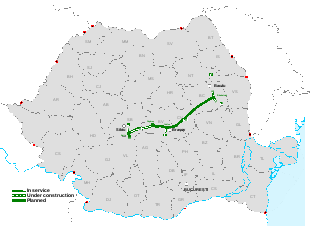
The Sibiu–Brașov–Bacău Motorway is a planned motorway in the central part of Romania, designed to connect Sibiu and Bacău counties, via Brașov. The project is currently regarded as composed of three sections Boița – Făgăraș, Făgăraș – Brașov, and Brașov – Răcăciuni, planned to be 282 kilometres (175 mi) long.
The Caragele gas field is a natural gas field located in Luciu, Buzău County, Romania in the RG06 block. Announced by Romgaz on June 30, 2016, it was one of the largest onshore gas fields discovered in the country since 2005, with a length of 35 km (22 mi), depth of 4,000 m (13,000 ft), and total proven reserves of around 986 billion ft3 (28.2 km3). Sorin Grindeanu, the Prime Minister of Romania at the time, dubbed it "the most important discovery" since the fall of communism in 1989.
The 2018–19 Liga III was the 63rd season of Liga III, the third tier of the Romanian football league system. The season began on 24 August 2018 and ended on 25 May 2019.
The Circassians in Romania were an ethnic minority in the territory that constitutes modern Romania. The presence of people with names derived from the Circassians in lands belonging now to Romania was attested since at least the 15th century. For the next few centuries, these records of such people in the Romanian principalities of Moldavia and Wallachia would continue.
